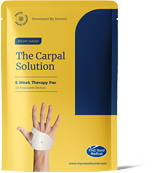What is the Success Rate of Carpal Tunnel Surgery?
Patients are often told that success rates are high (over 90%) for Carpal Tunnel Surgery when they visit the surgeon’s office. However, patients know so many people who need Repeat Carpal Tunnel Surgeries or have friends for which Surgery did not work at all.


By The Carpal Solution Medical Team Over 300 years combined medical experience

What is the Success Rate of Carpal Tunnel Surgery?
Patients are often told that success rates are high (over 90%) for Carpal Tunnel Surgery when they visit the surgeon’s office. However, patients know so many people who need Repeat Carpal Tunnel Surgeries or have friends for which Surgery did not work at all.


By The Carpal Solution Medical Team Over 300 years combined medical experience

Carpal Tunnel Surgery Success Rate – Get The Facts
 Carpal Tunnel Release Surgery is one of the most performed procedures in medicine. Almost everyone knows someone that has had it. It is one of the quickest and easiest surgeries from a Surgeon’s perspective.
Carpal Tunnel Release Surgery is one of the most performed procedures in medicine. Almost everyone knows someone that has had it. It is one of the quickest and easiest surgeries from a Surgeon’s perspective.
It can be confusing to try to understand all the different points of view. Where does the confusion over the success of the surgery stem from?
Surgeons will often define success for a surgical procedure very differently than how patients define success, so it is in the definition of success that the confusion is created.
Surgeons typically will deem a surgery successful if any of the original symptoms are eliminated immediately after surgery or if there are any improvements after surgery. By this standard, Carpal Tunnel Release Surgery yields high success rates, because once the Transverse Carpal Ligament is severed, the pressure on the Median Nerve is eliminated and some of the original symptoms are usually relieved.
However, a patient’s point of view can be very different from the surgeon’s point of view. To a Patient, if only some of the symptoms improve, but not all of the symptoms, the surgical procedure is not considered a success. Also, Patients deem success of a surgical procedure based on how quickly they recover without lingering effects. Recovery can take anywhere from 6 weeks to over a year to regain some of the basic functionality with painstaking rehabilitation programs and a lot of downtime. All that downtime can be very frustrating to a patient who depends on their hands for the most basic of needs of everyday life.
$1,200
Average Out-Of-Pocket Expenses For Carpal Tunnel Surgery
$12,000
Cost Of Carpal Tunnel Surgery Without Insurance
85%
Percentage Of People Experiencing Carpal Tunnel Symptoms Even After Successful Surgery
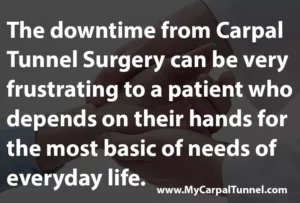 Also, most patients report permanent tenderness over the point of incision for years after surgery. Patients also report a permanent loss of grip strength for years. These are issues they were not informed about before surgery and so it causes frustration, misunderstanding and a lack of trust in the system.
Also, most patients report permanent tenderness over the point of incision for years after surgery. Patients also report a permanent loss of grip strength for years. These are issues they were not informed about before surgery and so it causes frustration, misunderstanding and a lack of trust in the system.
Some people experience a build-up of scar tissue around the Carpal Tunnel during the healing process and in these cases the symptoms of Carpal Tunnel will be worse after surgery than the symptoms were before.
For some people the symptoms are relieved immediately after surgery, but once the transverse carpal ligament scars back together, it has the same space as before and the symptoms return when they resume full activity with their hands.
Can Carpal Tunnel Symptoms Return After Surgery?

Probably the biggest point of contention is when the surgery is completed, the patient has undergone a long rehabilitation and finally gained back their hand/wrist functionality and within a year or two the symptoms come back. It is a dreadful feeling for a patient to undergo a surgical procedure, with an extended rehabilitation and all the downtime and risks, only to find that their symptoms are back.
Repeat surgical procedures are more complicated than the original procedure and the success rates are always much lower because of the potential for scar tissue and the overall weakening of the supporting tissue around the joints. Medical textbooks suggest strongly that surgery for Carpal Tunnel should not be performed more than twice on one hand.
So, it can be frustrating for a patient to undergo the ordeal of surgery only to find that they are facing another procedure and what to expect after. Is one just expected to endure the hand pain, numbness, clumsiness and sleep loss when the symptoms come back after the second surgery?
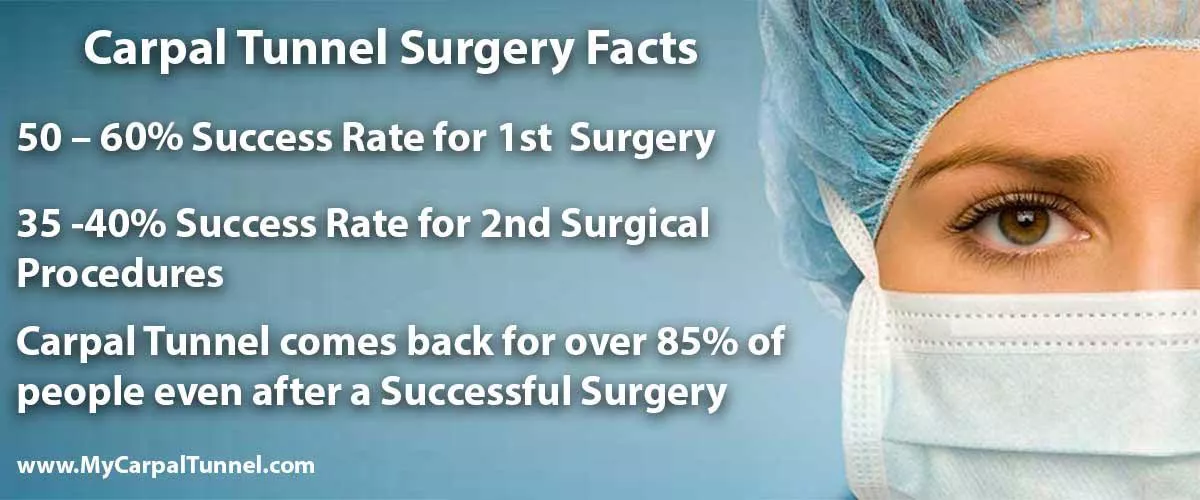
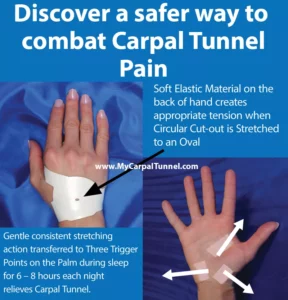 The trauma and psychological stress of repeat surgeries with recurring symptoms and loss of function can lead to depression and anxiety in patients. It can be a very frustrating process to go through.
The trauma and psychological stress of repeat surgeries with recurring symptoms and loss of function can lead to depression and anxiety in patients. It can be a very frustrating process to go through.
About 15% of patients find that the Carpal Tunnel Space is increased after the Transverse Carpal Ligament heals back together. For these people they usually do not have to undergo repeat surgeries.
When patients are consulted on the success rate of the CT procedure, The success rate comes in at about a 50 to 60% success rate. Also, for those patients who have not yet had to endure a second surgery. They are in a state of bliss thinking they had a successful permanent fix to their carpal tunnel woes, not knowing that it will likely come back. So, the 50 to 60% success rate is probably inflated somewhat by those patients who think they are cured, but the symptoms will eventually come back. Carpal Tunnel Syndrome comes back for over 85% of people within 6 months to 8 years of a successful surgical procedure.
We believe that people should go into a surgical procedure with their eyes wide open to the facts. You can rely on this website backed by leading doctors to get the facts about Carpal Tunnel diagnosis and treatment.
We hope this helps to explain the different points of view on the success rate of Carpal Tunnel Surgery.
Explore further reading:
The Carpal Solution alternative to surgery is Self-Applied Before Retiring to Bed in Three Easy Steps
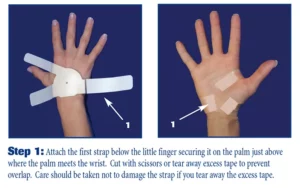

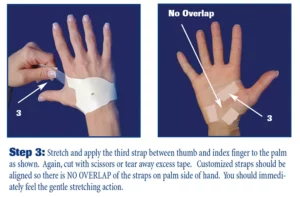
 The Carpal Solution is FDA registered and made in a FDA registered facility.
The Carpal Solution is FDA registered and made in a FDA registered facility.

